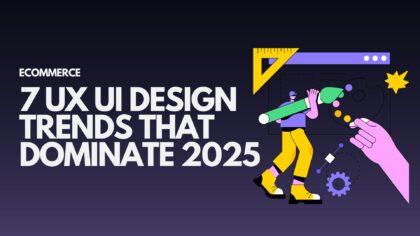How UI/UX Design Impacts Conversion Rates on E-Commerce Sites | Boost Sales

In today’s fast-paced digital world, your e-commerce site’s success largely depends on how effectively users can navigate and interact with it. When it comes to optimizing conversions, UI/UX (User Interface/User Experience) design plays a crucial role. The right design can lead to higher engagement, more repeat visitors, and ultimately, increased sales. If you want to improve your conversion rates, you need to understand the powerful impact of UI/UX design.
Let’s dive into how UI/UX design affects your e-commerce site’s performance and what steps you can take to optimize your site for better conversion rates.
- What is UI/UX Design and Why Does It Matter for E-Commerce?
- How UI/UX Design Affects User Behavior
- The Role of Navigation and Layout in Conversion Rates
- Visual Design and Aesthetics: Influencing Trust and Sales
- Mobile Optimization: A Crucial Factor for Conversion
- The Importance of Page Speed and Load Times
- Effective Product Pages and Checkout Process
- A/B Testing and Continuous Improvements
What is UI/UX Design and Why Does It Matter for E-Commerce?
UI design refers to the visual layout of a website—buttons, images, typography, and other graphical elements. UX design, on the other hand, focuses on the user’s experience, ensuring that the site is easy to navigate, intuitive, and efficient.
In an e-commerce context, both UI and UX design work together to ensure that potential customers can browse, select, and purchase products effortlessly. If users can’t easily understand your site or navigate through it, they’re unlikely to convert.
A well-designed UI/UX can:
- Make your site more visually appealing and intuitive
- Guide users towards key actions (like making a purchase)
- Encourage return visits by providing a seamless, enjoyable shopping experience
How UI/UX Design Affects User Behavior
The role of UI/UX design in shaping user behavior is undeniable. Poor design leads to frustration, confusion, and ultimately, cart abandonment. Conversely, a smooth and pleasant experience encourages users to stay longer and engage more.
- First Impressions Matter: Within seconds of visiting your site, users form opinions based on its design. If it’s cluttered, slow, or hard to navigate, they’ll likely leave and not return. A clean, attractive design builds trust and encourages users to explore further.
- User Flow: The flow of the site—how users navigate from one page to the next—is a key UX element. A logical, simple flow makes it easier for users to find what they’re looking for, increasing the likelihood of a purchase.
- Ease of Use: Users don’t want to struggle to find products or checkout. If your design is complicated or confusing, users will abandon their carts. Smooth navigation leads to fewer drop-offs.
The Role of Navigation and Layout in Conversion Rates
A clear and intuitive layout is crucial for higher conversion rates. If visitors can’t quickly find what they need, they’re less likely to make a purchase. Optimizing the site’s navigation is one of the simplest and most effective ways to boost conversions.
- Menu Structure: Categorize products logically and use clear labeling to help users easily find what they’re looking for.
- Search Functionality: Implement a robust search feature with filters to help users narrow down their choices quickly.
- Responsive Design: Ensure that your navigation works seamlessly across all devices, from desktop to mobile.
Visual Design and Aesthetics: Influencing Trust and Sales
The visual appeal of your website directly impacts user trust, which in turn affects conversion rates. According to studies, users are more likely to purchase from sites that look trustworthy and professionally designed.
- Consistent Branding: Use consistent colors, fonts, and styles throughout the site to build a cohesive identity and make it more memorable.
- High-Quality Images: Provide high-resolution product images to give customers a better idea of what they’re buying.
- Clear Calls to Action: Make buttons and links easy to find, with action-oriented text (e.g., “Buy Now,” “Add to Cart”).
Mobile Optimization: A Crucial Factor for Conversion
With more people shopping on mobile devices than ever before, it’s essential that your e-commerce site is optimized for mobile users. Mobile optimization isn’t just about making the site look good—it’s about ensuring that it works seamlessly and loads quickly.
- Responsive Design: Your site should automatically adjust its layout for smaller screens without losing functionality or aesthetic appeal.
- Touch-Friendly Features: Ensure that buttons and forms are easy to tap and fill out on mobile devices.
- Fast Load Times: Mobile users expect quick load times—slow websites are a surefire way to lose conversions.
The Importance of Page Speed and Load Times
Page speed is a critical factor in both user experience and SEO. Research shows that if a website takes more than 3 seconds to load, the chances of a visitor bouncing off the site increase by over 40%. For e-commerce, this can translate into significant lost revenue.
- Optimized Images: Compress images to reduce file size without compromising quality.
- Minimize HTTP Requests: Combine CSS and JavaScript files where possible to reduce the number of requests.
- Leverage Browser Caching: This stores parts of your site on a user’s browser, speeding up load times for return visitors.
Effective Product Pages and Checkout Process
Once users find a product they’re interested in, your product pages need to help convert them into paying customers. The product page is one of the most critical pages for conversion.
- Product Descriptions: Write clear, concise descriptions that highlight key features and benefits.
- Customer Reviews: Display user reviews and ratings to help potential buyers feel more confident in their purchase.
- Easy Checkout: A complicated checkout process leads to cart abandonment. Keep it simple, and offer multiple payment options to cater to a broad audience.
A/B Testing and Continuous Improvements
No matter how good your UI/UX design is, there’s always room for improvement. A/B testing allows you to experiment with different elements of your site to determine which design leads to higher conversion rates.
- Test One Element at a Time: Start with high-impact elements like CTAs, product page layouts, or checkout flow.
- Analyze Results: Track metrics like click-through rates, bounce rates, and conversion rates to determine which design performs better.
- Iterate Based on Data: Use the data to refine your design continually and improve user experience.
Conclusion
UI/UX design has a profound impact on conversion rates for e-commerce sites. By focusing on user-friendly navigation, attractive visuals, mobile optimization, fast load times, and a seamless checkout experience, you can significantly improve your site’s performance.
Don’t forget to use A/B testing to continuously refine your design based on actual user behavior. The more you invest in enhancing your UI/UX, the better your chances of boosting sales and keeping your customers coming back for more.
Expert UI/UX Design Consulting and Services Across India
Looking for top-notch UI/UX design consulting? We’ve got you covered! At Emerge Digital, we proudly offer our services in major cities across India, including Ui UX Mumbai, Ui UX in Bangalore, Ui UX in Delhi, Ui UX in Pune, Ui UX in Hyderabad, Ui UX in Chennai, and Ui UX in Ahmedabad. Whether you need a full redesign, ongoing UX consulting, or specific UI/UX improvements for your product, we’re here to provide personalized, expert solutions tailored to your business needs.
Our team brings the best of design thinking, user research, and creative innovation to every project, ensuring you get exceptional digital experiences that resonate with your audience, no matter where you’re located.
Ready to elevate your UX? Let’s work together and make your product shine!
Get in touch today!
Explore More
UI/UX Design Costs in India: A Comprehensive Guide
Digital Product Design vs. UI/UX Design: A Comprehensive Guide

About the Author
Priya, Co-Founder of Emerge Digital, is a UI/UX enthusiast with 15 years of experience. She’s passionate about crafting user-centered designs that exceed expectations, delivering meaningful and engaging digital experiences. At Emerge Digital, Priya blends her deep expertise with a commitment to client and user needs, driving innovative design solutions.






